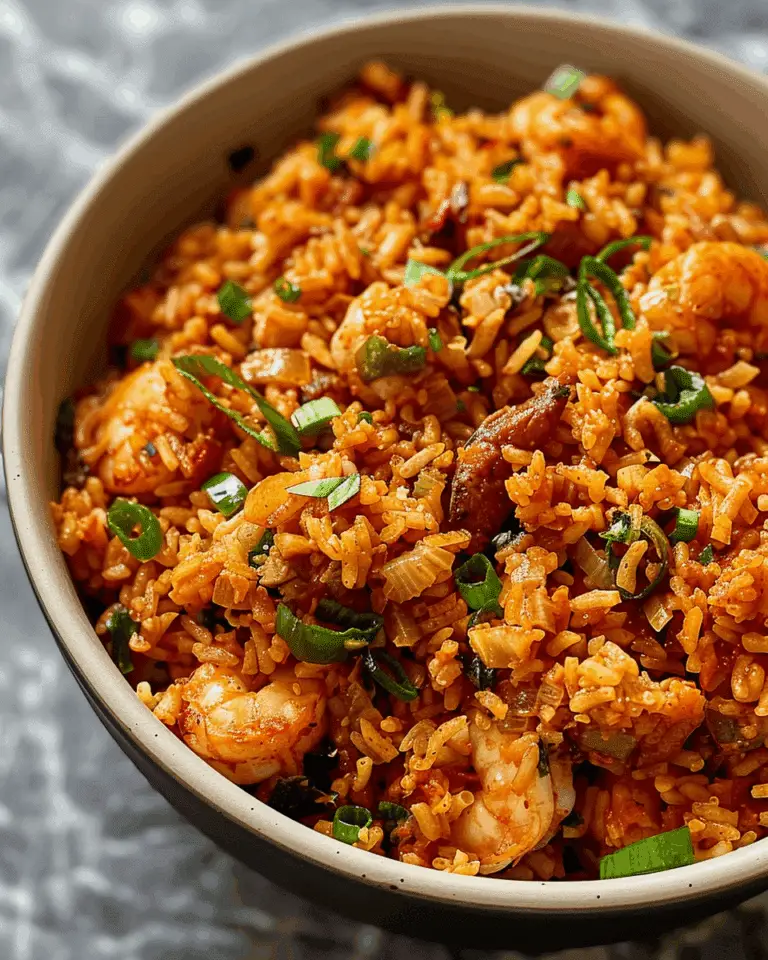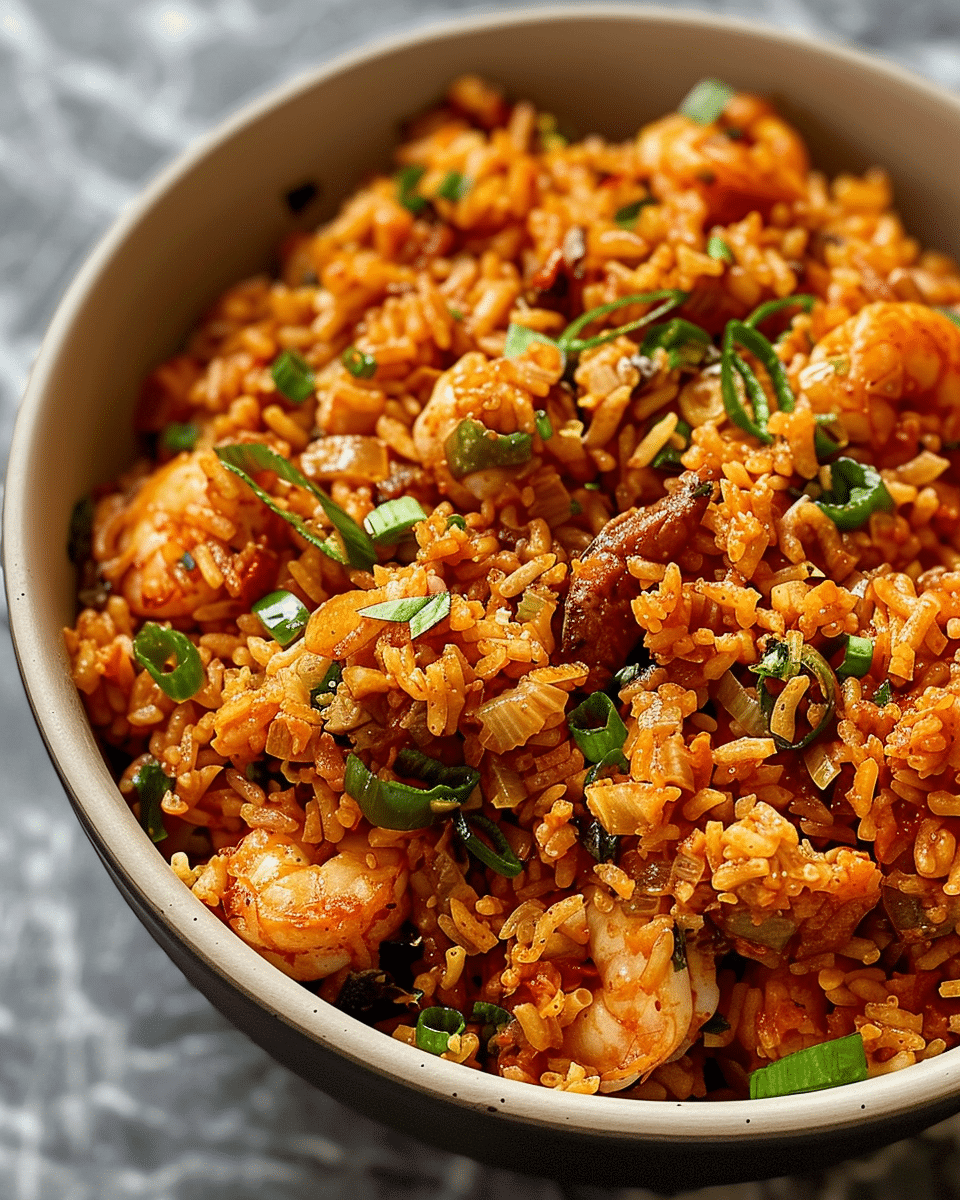A rich and flavorful one-pot Cajun classic combining chicken, shrimp, sausage, and rice in a perfect harmony of Southern comfort food. This authentic jambalaya brings the spirit of New Orleans right to your dinner table with its bold flavors and hearty texture.
Why You’ll Love This Recipe
This jambalaya recipe delivers an explosion of authentic Cajun flavors in every bite. It’s a complete meal in one pot, making cleanup a breeze. The combination of proteins—chicken, sausage, and shrimp—ensures a satisfying meal that will please the whole family. Perfect for Mardi Gras celebrations or any time you’re craving Southern comfort food, this recipe is surprisingly straightforward despite its complex flavors. The holy trinity of Cajun cooking (onion, bell pepper, and celery) creates a flavorful base that transforms simple ingredients into something truly special.
Ingredients
(Tip: You’ll find the full list of ingredients and measurements in the recipe card below.)
Chicken thighs are the ideal choice for jambalaya as they stay tender and juicy throughout the cooking process, unlike breast meat which can dry out. Their richer flavor also adds depth to the dish.
Shrimp brings a delicate sweetness and quick-cooking protein to balance the heartier components. They’re added at the end to prevent overcooking, ensuring perfect texture.
Andouille sausage provides that distinctive Cajun flavor with its smoky, garlicky profile. If unavailable, smoked kielbasa makes a decent substitute, though it will be less spicy.
Onion, green bell pepper, and celery form the “holy trinity” of Cajun cooking, creating the aromatic foundation for authentic jambalaya. Don’t skip this crucial flavor base.
Garlic adds essential pungency that complements the other flavors without overwhelming them.
Chicken broth infuses the rice with savory flavor as it cooks. Use low-sodium varieties if you’re watching salt intake.
Long-grain rice is traditional for jambalaya because it cooks up fluffy and distinct, allowing it to absorb the flavorful broth without becoming mushy.
Cajun seasoning blends several spices into one convenient mix, typically including paprika, cayenne, garlic powder, and herbs. Adjust the amount based on your spice preference.
Olive oil helps brown the meats and sauté the vegetables, developing deeper flavors through caramelization.
Directions
- Heat olive oil in a large pot over medium heat. Add the sausage and chicken, cooking until browned, about 5 minutes.
- Stir in the onion, bell pepper, celery, and garlic, and cook for 5 more minutes until softened.
- Add Cajun seasoning and chicken broth, bringing to a gentle boil.
- Stir in rice, reduce heat to low, cover the pot, and simmer for about 20 minutes, or until the rice has absorbed most of the liquid.
- In the last few minutes, stir in the shrimp until they turn pink and are fully cooked.
- Serve warm and enjoy!
Servings and Timing
This jambalaya recipe yields 6 generous servings, making it perfect for family dinners or small gatherings. The preparation takes approximately 15 minutes, with a cooking time of 30 minutes, bringing the total time to around 45 minutes. Each serving contains approximately 450 calories, offering a satisfying meal that combines proteins, carbohydrates, and vegetables in one delicious dish.
Variations
Creole Jambalaya: Add a 14-oz can of diced tomatoes when you add the broth for a “red” jambalaya in the Creole style.
Vegetarian Option: Skip the meats and shrimp and double up on vegetables, adding mushrooms, zucchini, and red bell peppers. Use vegetable broth instead of chicken broth.
Seafood Jambalaya: Omit the chicken and sausage, and increase the shrimp to 1.5 pounds. Add 1/2 pound of lump crab meat and 1/2 pound of bay scallops during the last 5 minutes of cooking.
Spicy Version: Add 1-2 minced jalapeños with the vegetables and include a dash of hot sauce at the end.
Smoky Jambalaya: Add 1 teaspoon of smoked paprika along with the Cajun seasoning for an enhanced smoky flavor.
Storage/Reheating
Refrigeration: Store leftover jambalaya in an airtight container in the refrigerator for up to 3-4 days. The flavors often deepen overnight, making it even more delicious the next day.
Freezing: Jambalaya freezes well for up to 3 months. Portion it into freezer-safe containers, leaving some room for expansion. Thaw overnight in the refrigerator before reheating.
Reheating: For the best texture, reheat jambalaya on the stovetop over medium-low heat with a splash of chicken broth or water to prevent drying out. Stir occasionally until heated through. Microwaving is also an option – use 50-70% power and stir halfway through for even heating.
Meal Prep: Jambalaya makes excellent meal prep for the week. Divide into individual portions for easy lunches or dinners.

FAQs
What makes jambalaya different from gumbo?
Jambalaya is a rice-based dish where all ingredients cook together, resulting in rice that absorbs the flavors. Gumbo, on the other hand, is more like a stew served over separately cooked rice and typically includes a roux as its base, giving it a different texture and flavor profile.
Can I use brown rice instead of white rice?
Yes, brown rice can be substituted, but you’ll need to adjust the cooking time and liquid amount. Brown rice typically requires about 45 minutes to cook and may need an additional cup of broth. The texture will be chewier and nuttier.
My rice turned out mushy. What went wrong?
Mushy rice usually results from too much liquid or overcooking. Ensure you’re using the correct rice-to-liquid ratio and follow the recommended cooking time. Also, avoid stirring the rice too frequently while it cooks, as this releases more starch.
Is jambalaya supposed to be spicy?
Traditional jambalaya has a moderate level of spice, but you can easily adjust the heat level by varying the amount of Cajun seasoning or adding hot sauce to taste. Authentic Cajun cooking is flavorful but not necessarily overwhelming in heat.
Can I make jambalaya ahead of time for a party?
Yes, jambalaya is an excellent make-ahead dish. Prepare it up to a day in advance, refrigerate, and reheat gently on the stovetop with a splash of broth. Some even prefer day-old jambalaya as the flavors have time to meld.
What’s the difference between Cajun and Creole jambalaya?
Cajun jambalaya (brown jambalaya) doesn’t contain tomatoes and has a darker color from the browned meats. Creole jambalaya (red jambalaya) includes tomatoes, giving it a red hue and slightly tangier flavor.
Can I use frozen shrimp?
Absolutely. Thaw frozen shrimp completely before adding to the jambalaya. Pat them dry with paper towels to remove excess moisture, which could water down your dish.
What can I serve with jambalaya?
Jambalaya is a complete meal on its own, but it pairs nicely with a simple green salad, crusty French bread, or cornbread. For a true New Orleans experience, serve with a side of collard greens.
My jambalaya seems too dry. How can I fix it?
If your jambalaya seems too dry during cooking, simply add a bit more hot chicken broth, about 1/4 cup at a time. Let it absorb before deciding if more is needed. Remember that jambalaya should be moist but not soupy.
Can I omit the seafood if someone has allergies?
Certainly. You can make a delicious jambalaya with just chicken and sausage. Simply increase those proteins slightly to maintain the hearty nature of the dish. This variation is actually quite traditional in parts of Louisiana.
Conclusion
This classic jambalaya recipe brings the vibrant flavors of New Orleans right to your kitchen with minimal effort and maximum impact. The beauty of jambalaya lies in its versatility – once you master this basic recipe, you can adapt it to your preferences or what you have on hand. The one-pot nature makes it perfect for both weeknight dinners and special occasions like Mardi Gras celebrations. The combination of the holy trinity vegetables, savory proteins, and perfectly seasoned rice creates a harmonious dish that transports you straight to the French Quarter. Whether you’re a Cajun cooking novice or a seasoned pro, this jambalaya recipe deserves a permanent place in your culinary repertoire.
Print
Best Jambalaya Recipe for Mardi Gras
A flavorful Jambalaya recipe packed with chicken, shrimp, Andouille sausage, and vegetables, perfect for Mardi Gras celebrations.
- Total Time: 45 minutes
- Yield: 6 servings
Ingredients
- 1 lb boneless chicken thighs, cut into bite-sized pieces
- 1 lb shrimp, peeled and deveined
- 1 lb Andouille sausage, sliced
- 1 large onion, chopped
- 1 green bell pepper, chopped
- 2 stalks celery, chopped
- 4 cloves garlic, minced
- 6 cups chicken broth
- 3 cups long-grain rice
- 2 teaspoons Cajun seasoning
- Olive oil for cooking
Instructions
- Heat olive oil in a large pot over medium heat. Add the sausage and chicken, cooking until browned, about 5 minutes.
- Stir in the onion, bell pepper, celery, and garlic, and cook for 5 more minutes until softened.
- Add Cajun seasoning and chicken broth, bringing to a gentle boil.
- Stir in rice, reduce heat to low, cover the pot, and simmer for about 20 minutes, or until the rice has absorbed most of the liquid.
- In the last few minutes, stir in the shrimp until they turn pink and are fully cooked.
- Serve warm and enjoy!
Notes
- For extra heat, add more Cajun seasoning or some hot sauce.
- You can use other proteins like crawfish, sausage alternatives, or omit meat for a vegetarian version.
- Leftovers can be refrigerated and reheated the next day.
- Prep Time: 15 minutes
- Cook Time: 30 minutes
- Category: Main Dish
- Method: Stovetop
- Cuisine: Cajun
- Diet: Gluten Free
Nutrition
- Serving Size: 1 serving
- Calories: 450 kcal
- Sugar: 4 g
- Sodium: 900 mg
- Fat: 12 g
- Saturated Fat: 3 g
- Unsaturated Fat: 8 g
- Trans Fat: 0 g
- Carbohydrates: 55 g
- Fiber: 3 g
- Protein: 30 g
- Cholesterol: 150 mg


